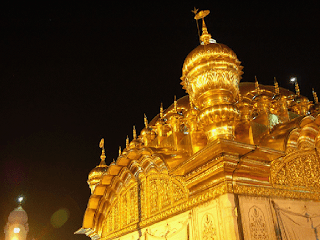Golden Temple, informally referred to as The Golden Temple or Temple of God, is culturally the most significant place of worship of the Sikhs and one of the oldest Sikh gurdwaras. It is located in the city of Amritsar, which was established by Guru Ram Das Ji, the fourth guru of the Sikhs, and is, also due to the shrine, known as Guru Di Nagri meaning city of the Guru.
The Harmandir Sahib is considered the most holiest shrine by Sikhs. The 11th and eternal Guru Sri Guru Granth Sahib Ji is present inside it. It is moved to the Sri Akal Takhat Sahib at around 10 PM and then moved back from there to Sri Harmandir Sahib at 4.45 AM, site contains the time schedule, please note that there might be changes in the timing as per the season. Its construction was mainly intended as a place of worship for men and women from all walks of life and all religions to come and worship God equally. The Sri Guru Granth Sahib is the holiest literature in the Sikh religion, the tenth Guru of Sikhs, Sri Guru Gobind Singh on 7 October 1708 made it the eternal Sikh Guru and the leader of Sikhism. Anywhere in the world where the Guru Granth Sahib is present is equally holy and precious to Sikhs. Harmandir Sahib was built with four doors to show that every religion or faith is allowed to go in to meditate or just listen to the prayers for peace.
The fourth Guru of Sikhism, Guru Ram Das, excavated a tank in 1577 which subsequently became known as Amritsar (meaning: Pool of the Nectar of Immortality), giving its name to the city that grew around it. In due course, a splendid Sikh edifice, the Harmandir Sahib (Temple of God) was constructed in the middle of this tank which became the supreme centre of Sikhism. Its sanctum came to house the Adi Granth comprising compositions, Sikh values, philosophies and teachings of the Sikh Gurus and other saints of Guru Nanak's time, e.g. Ravidas a Hindu Guru, Baba Farid a Sufi Sant (Saint) and Kabir, all of whom the Sikhs refer to as the Bhagats.
The compilation of the Adi Granth was started by the fifth Guru of the Sikhs, Guru Arjun Dev.
Amritsar is located in the Majha region of the Punjab. Majha is also known as the Bari Doab, since it is the Doab (Do = two, ab = rivers) or the (fluvial) tract of land which lies between two of the five great rivers of the province, the Ravi and the Beas. As such, Majha lies in the heart of the ancient Punjab region, comprising Gurdaspur, Batala and Tarn Taran Sahib as well as Amritsar. Amritsar is also known as "Sifti Da Ghar" or Adorable Abode.
[
Harmandir Sahib at nightOriginally built during AD 1574, the site of the temple was surrounded by a small lake in a thin forest. The third of the six grand Mughals, emperor Akbar, who visited the third Sikh Guru, Guru Amar Das, at the neighbouring town of Goindval was so impressed by the way of life in the town that he gave a jagir (the land and the revenues of several villages in the vicinity) to the Guru's daughter Bhani as a gift on her marriage to Bhai Jetha, who later became the fourth Sikh Guru, Guru Ram Das. Guru Ram Das enlarged the lake and built a small township around it. The town was named after Guru Ram Das as "Guru Ka Chak", "Chak Ram Das" or "Ram Das Pura".
During the leadership of the fifth Guru, Guru Arjan Dev Ji (1581-1606), the full-fledged Temple was built. In December 1588 the great Muslim Sufi saint of Lahore, Hazrat Mian Mir, a close friend of Guru Arjan Dev Ji, was asked to lay the corner stone (December 1588) The story has been told that a mason then straightened the stone, to which Guru Arjan said, as you have just undone the work of such a holy man, who knows what disaster might come to the Harmandir Sahib. This story has been used to offer a reason why the temple has been attacked so many times by the Afghans and Mughals and even the Indian Army in 1984, during Operation Bluestar, which laid the foundation stone of Khalistan, the proposed rebellious Sikh Homeland.
The temple was completed in 1604. Guru Arjan Dev Ji, installed the Adi Granth in it and appointed Baba Buddha Ji as the first Granthi (Reader) of the temple on August 1604. In the mid 18th century it was attacked by the Afghans, by one of Ahmed Shah Abdali's Generals, Jahan Khan, and had to be substantially rebuilt in the 1760s. However, in response a Sikh Army was sent to hunt down the Afghan force. They were under orders to show no mercy and historical evidence suggests none was shown. Both forces met each other 5 miles outside Amritsar where Jahan Khan's army was destroyed. He himself was decapitated by commander Sardar Dayal Singh. This is beautiful INDIA.















No comments:
Post a Comment